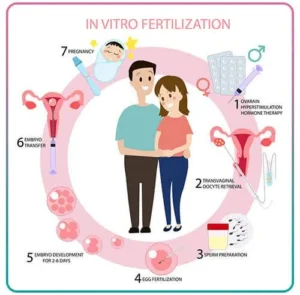Introduction:
Fertility is a fundamental aspect of human life, encompassing the ability to conceive and reproduce. While the process of fertility might seem straightforward, it is influenced by various factors that can impact an individual or couple’s ability to conceive. This blog post aims to provide an overview of fertility, including how it works, factors that affect fertility, and common fertility issues.
Understanding Fertility:
Fertility refers to the natural capability of a person to reproduce. It involves the successful union of an egg and sperm, leading to fertilization and subsequent implantation in the uterus. Fertility is not solely determined by women; men play an equally important role in the process.
The Menstrual Cycle and Ovulation:
In women, fertility is closely tied to the menstrual cycle. On average, a menstrual cycle lasts around 28 days, although it can vary from person to person. The menstrual cycle is divided into two main phases: the follicular phase and the luteal phase.
During the follicular phase, which begins on the first day of menstruation, hormones stimulate the ovaries to develop and mature an egg within a fluid-filled sac called a follicle. Approximately halfway through the cycle, ovulation occurs. This is when the mature egg is released from the ovary and travels down the fallopian tube towards the uterus, where it can be fertilized.
Fertilization and Implantation:
For fertilization to occur, sperm must be present in the fallopian tube during ovulation. When sperm enters the fallopian tube, it can potentially fuse with the egg, resulting in fertilization. The fertilized egg, now called an embryo, starts dividing and develops as it travels through the fallopian tube toward the uterus.
If the embryo successfully reaches the uterus, it can implant into the uterine lining, leading to pregnancy. However, if implantation does not occur, the uterine lining sheds during menstruation, and the cycle begins again.
Factors Affecting Fertility:
Numerous factors can impact fertility for both men and women. Some key factors include:
Age: Fertility declines as women age, with a more significant decline after the age of 35. Men also experience a gradual decline in fertility, but it tends to be more gradual.
Health and Lifestyle: Overall health, including body weight, nutrition, and habits such as smoking, alcohol consumption, and drug use, can influence fertility in both men and women.
Hormonal Imbalances: Hormonal disorders, such as polycystic ovary syndrome (PCOS) in women or low testosterone levels in men, can affect fertility.
Reproductive Disorders: Conditions like endometriosis, fibroids, blocked fallopian tubes, or issues with the sperm count, motility, or morphology can impact fertility.
Environmental Factors: Exposure to certain chemicals, toxins, radiation, or prolonged heat can affect reproductive health.
Common Fertility Issues:
Several fertility issues are commonly encountered by individuals or couples trying to conceive. Some prevalent fertility issues include:
Infertility: Infertility is defined as the inability to conceive after a year of regular unprotected intercourse. It can be caused by various factors, including hormonal imbalances, structural abnormalities, or reproductive disorders.
Polycystic Ovary Syndrome (PCOS): PCOS is a hormonal disorder affecting women, characterized by irregular menstrual cycles, elevated androgen levels, and multiple small cysts on the ovaries. PCOS can hinder ovulation and make it difficult to conceive.
Endometriosis: Endometriosis is a condition where the tissue lining the uterus grows outside the uterus, leading to pelvic pain, inflammation, and fertility issues. The abnormal tissue can block the fallopian tubes or interfere with egg implantation.
Male Factor Infertility: Issues such as low sperm count, poor sperm motility, or abnormal sperm morphology can contribute to male factor infertility.
Conclusion:
Understanding fertility is essential for individuals and couples seeking to start a family. By comprehending the basics of fertility, including how it works, factors that influence fertility, and common fertility issues, individuals can make informed decisions about their reproductive health. While fertility challenges can be disheartening, advancements in medical science and assisted reproductive technologies provide hope and options for those facing fertility issues, making the dream of parenthood achievable for many. Written by Ugoru Okeoghene Veronica


